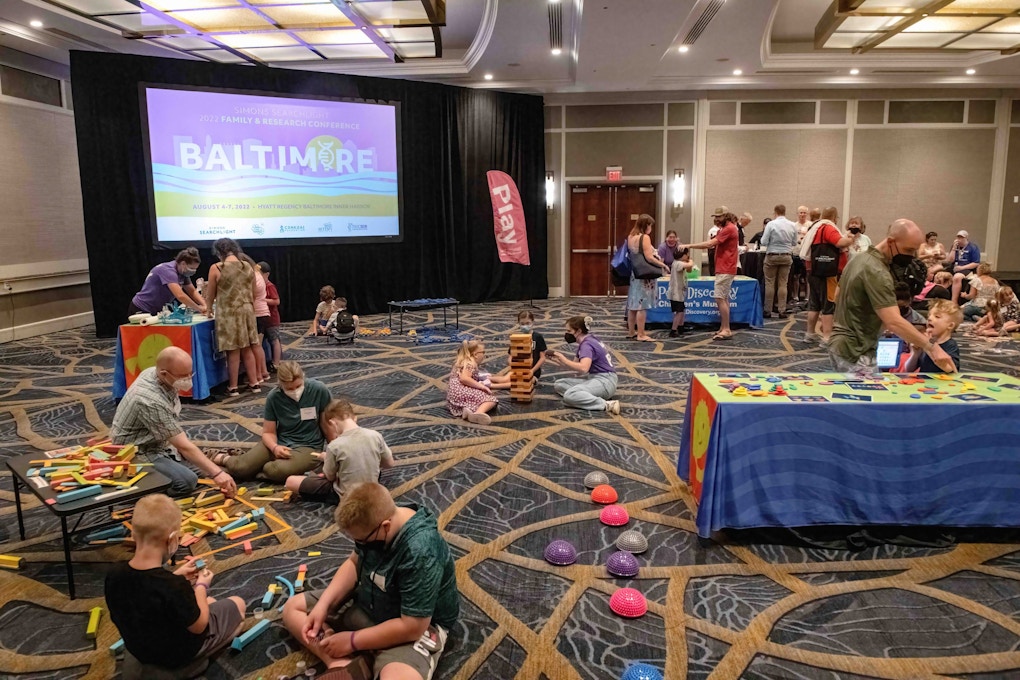
On August 4, 2022, SFARI and Simons Searchlight helped to host two scientific workshops focused on neurodevelopmental disorders (NDDs) that are linked to mutations in the CSNK2A1 and SETBP1 genes. Meeting in Baltimore, the workshops were held in conjunction with a family conference that gathered together people with these conditions and their family members.
As genetic studies of autism spectrum disorder (ASD) have yielded over 100 risk genes, researchers are now delving into the individual genes to understand their roles in brain development and behavior. Although mutations to these genes are rare, family advocacy organizations and platforms like Simons Searchlight have helped gather people with mutations to the same gene, which facilitates research. Simons Searchlight chose to focus on CSNK2A1– and SETBP1–related conditions because their associated family groups are highly engaged and growing and because an emerging group of scientists working on these genes are interested in collaborating.
The two scientific workshops brought together scientists who study the CSNK2A1 and SETBP1 genes with researchers who study the clinical picture of the related syndromes. Loss-of-function mutations in CSNK2A1 result in Okur-Chung Neurodevelopmental Syndrome (OCNDS), whereas loss-of-function mutations in SETBP1 result in SETBP1 Haploinsufficiency Disorder (SETBP1-HD).
“This was the first time many of these people were in the room together,” said Michael Boland, a SFARI consultant and researcher at Columbia University.
The meeting also provided a unique opportunity for researchers to meet children with these NDDs, which can inform their work back in the lab. “For many of these scientists, the chance to meet someone with a mutation in the gene that they study does not come along very often,” Boland said.
Scientists also set up eight in-person research stations, at the conference center to collect data from families interested in participating. These included studies to characterize movement, speech, and EEGs of those with mutations in CSNK2A1 and SETBP1, as well as in HIVEP2 and MED13L genes. Blood samples were also collected from willing families. These samples will become a resource for future genomic studies, and they will expedite the creation of patient-derived induced pluripotent stem cells (iPSCs). Researchers reported that families were very motivated to participate in these studies, and galvanized to fill knowledge gaps.
“These meetings can help us set priorities and identify the key questions to answer in order to develop therapies,” said Wendy Chung of Simons Searchlight and Columbia University.
CSNK2A1 Scientific Workshop: A kinase conundrum
Jennifer Sills of the CSNK2A1 Foundation and mother to a child with OCNDS, opened the meeting with Wendy Chung, who first described OCNDS with Volkan Okur in 20161. A rare condition, OCNDS stems from mutations in the CSNK2A1 gene, which encodes a casein kinase subunit called CK2alpha that is involved in DNA repair, cell replication, differentiation, and signaling. Heterozygous, de novo mutations in CSNK2A1 are associated with the neurodevelopmental abnormalities and dysmorphic features of OCNDS, which include speech challenges motor difficulties, intellectual disability, autism traits, short stature and microcephaly.
Sills described the progress that the foundation made in identifying people with OCNDS, which has helped to catalyze research. “Increased collaboration among researchers is key to successful rare disease research,” she said.
Research is now piecing together how the range of CSNK2A1 variants translate into OCNDS phenotypes. This work requires the identification and comparison of as many cases as possible. Kyle Retterer and Vincent Ustach of GeneDx, a diagnostic referral laboratory, presented some of their CSNK2A1 findings, which came from children who had been referred for genetic testing. Using computational methods, GeneDx has located “hot spots” in the CSNK2A1 gene that are enriched for OCNDS-related mutations that seem to flag domains critical to kinase function. Okur reviewed a series of chromosomal deletions of CSNK2A1 that are found in humans in effort to delineate the loss-of-function genetic phenotype from the missense presentation.
Elucidating the molecular outcomes of CSNK2A1 variants is aided by understanding their effects on the resulting protein structure and function. The alpha subunit encoded by CSNK2A1 is one of two subunits that catalyze kinase activity. This alpha subunit, along with a similar alpha’ subunit, combine with two beta subunits to form the kinase enzyme CK2. CK2 uses GTP or ATP to phosphorylate certain amino acids on target proteins. Using different methods, Jennifer Hochscherf of the University of Cologne and Danielle Caefer of the University of Connecticut focused their work on the K198R mutation, a recurrent missense mutation found in the OCNDS population. K198R affects substrate recognition, and thus shifts the enzyme’s phosphorylation target2,3. Their methods can be used to systematically explore the effects of other CSNK2A1 variants.
OCNDS-related variants might also alter the capability of CK2 to use ATP or GTP for phosphorylation. Karsten Niefind of the University of Cologne outlined how this “dual co-substrate specificity” is due to CK2’s unique structure4, and it might matter for the brain, which has higher levels of GTP than other tissues. Joachim Jose of the University of Münster described in vitro tests of CK2 enzyme activity, which found that common OCNDS-related variants impair the enzyme’s phosphorylation of target peptides. This reduction in activity was verified in brain tissue taken from mice that carry a common OCNDS variant. These mice were engineered by Alexander Gast, a student in Jose’s lab. Gast is also exploring the phosphorylation patterns of selected proteins in the brains from these mice. Together, these findings suggest that finding drugs to modulate CK2 activity could provide a therapeutic approach.
Animal models
Heike Rebholz of the Institute of Psychiatry and Neuroscience in Paris described a mouse model of OCNDS that carries the common K198R mutation in heterozygous mice. Characterization of the model is ongoing, with findings of differences in brain biochemistry, anatomy and behaviors including learning and memory, propensity for seizures and altered circadian rhythms.
Non-mammalian models will also have a role in understanding the mechanisms of OCNDS-related variants. Sampathkumar Rangasamy of the Translational Genomics Research Institute described his work to model CSNK2A1 variants in zebrafish, which could result in brain-related phenotypes that will be useful for drug screening. He is also studying the transcriptome patterns obtained from iPSCs, which may be used to predict drug responses in the future. Maria Isabel Dominguez of Boston University described her work to introduce OCNDS-related variants into developing frog embryos. Because experiments can precisely target the head, and because the embryos develop quickly, the frog model may provide a way to discern variants that alter development from those that do not.
To understand the association between NDDs and sleep, Ravi Allada of Northwestern University studies circadian rhythms, which can be found across the animal kingdom, including fruit flies, and which are governed by conserved biochemical pathways. Previous work by Allada has found that mutations to the fruit fly version of CSNK2A1 lengthens circadian period5. Thus, flies could offer a high throughput method to assess the impact of CSNK2A1 variants and other ASD-related variants on circadian rhythms.
Abdelhalim Loukil of Sanford Research and University of South Dakota presented work on primary cilia and their link to OCNDS. The primary cilium is a sensory organelle critical for processing environmental cues that guide embryonic development. Loukil has found that OCDNS-related mutations alter primary cilia morphology6 and ciliary trafficking.
In closing, Chung thanked the attendees. “Everyone was incredibly insightful, knowledgeable and engaged,” she said. “This is a way of doing team science and hopefully one that can facilitate meaningful research on OCNDS.”
SETBP1 science
The SETBP1 Scientific Workshop centered on SETBP1-related conditions. SETBP1 encodes a DNA-binding protein that forms part of a complex involved in chromatin remodeling and gene expression. Mutations to a region important for flagging the protein for degradation results in SETBP1 overexpression and Schinzel-Giedion syndrome (SGS), a severe condition marked by intellectual challenges, developmental delays, and a shortened lifespan. The workshop, however, was focused on SETBP1 variants occurring outside of this region that are associated with a range of neurodevelopmental symptoms, such as speech difficulties, delayed milestones, and intellectual challenges.
Haley Oyler, founder of the SETBP1 Society and mother to a child with SETBP1 Haploinsufficiency Disorder (SETBP1-HD), gave an update on the organization’s activities. Since its inception in 2017, the SETBP1 Society has registered over 160 families from 34 different countries. People with two categories of mutation are enrolled:
- those with SETBP1-HD, who have loss-of-function mutations (nonsense or frameshift) that reduce SETBP1 protein abundance7,8
- those with SETBP1-related conditions, who have missense mutations that alter the protein’s function without reducing its amount9
About 170 people with SETBP1-HD or SETBP1-related conditions have been identified worldwide, and researchers are working to determine the genotype-phenotype connection.
Simons Searchlight has also helped to gather the global rare disease community and has developed some patient-derived, induced pluripotent stem cells (iPSCs) that are available to researchers.
Boland described the need for basic science research on SETBP1, but with a therapeutic focus. “When developing a therapy, knowing disease mechanism is going to be key,” he said.
This would also involve identifying the features of the condition that might be reversible. “We have to develop an idea of what are the targets, and which phenotypes are available for therapeutic correction, and what the timeline of SETBP1 action is during development,” Boland added.
Oyler outlined important next steps for the field, which many of the talks centered on. These included identifying therapeutic targets, developing cellular and animal models, determining whether there is a critical period when interventions might need to happen, identifying the pathways or downstream targets affected by SETBP1 loss-of-function and setting up methods to screen existing compounds for therapeutic potential.
An emerging picture
Siddharth Srivastava of Harvard Medical School outlined the characteristic features of SETBP1-HD based on the first systematic evaluation of those with nonsense or frameshift SETBP1 mutations or SETBP1-specific deletions8. While physical growth was not impacted, the study found global delays that included motor and speech difficulties, a spectrum of intellectual challenges ranging from severe to mild to none, attention deficit hyperactivity disorder (ADHD)-like behavior, hypotonia and vision impairment. Focusing on speech and language, Angela Morgan of the Murdoch Children’s Research Institute in Australia described how genetic studies of childhood apraxia of speech have also turned up SETBP1 mutations10, 11. In a detailed study of speech and language features in those with SETBP1-HD, Morgan and colleagues found that although poor communication was a central feature, children made efforts to communicate, even when they were minimally verbal7. A longitudinal study is underway to quantitatively track speech and language development over three years in SETBP1-HD.
To understand what is most important to the parents of people with SETBP1-HD, Trina Geye and Stephanie Robertson of Tarleton State University described their efforts to create community-based participatory research with the SETBP1 Society. This partnership has yielded a measurement of parental stress, as well as a survey that highlighted the chief concerns for their children, to help focus research efforts.
Caitlin Hudac of University of South Carolina is pursuing biomarkers that indicate something about underlying brain processes in SETBP1-related and other monogenic NDDs. Hudac studies patterns of brain activity non-invasively with electroencephalography (EEG). Using a mobile setup, Hudac drove across the U.S. for 92 days last year, clocking 15,000 miles to collect data about attention processes from 55 people, many of whom are not ambulatory or verbal, as part of the BioGENE study (Biomarkers of Genetic Etiology of Neurodevelopmental Disorders). This project seeks to collect data from people with mutations in the GRIN2B, SCN2A, SETBP1, HIVEP2, CSNK2A1, and MED13L genes. The mobile approach enables research participation by those historically underrepresented in clinical studies, such as those who live in rural populations or internationally.
SETBP1 function in the brain
Numerous approaches have begun to probe SETBP1 function. Because SETBP1 is highly expressed in the developing brain, Maggie Wong of the Max Planck Institute for Psycholinguistics is exploring the role of SETBP1 in brain organoid development, recapitulating some of the earliest stages of brain growth. Genetically engineered iPSCs that lack either one or both copies of SETBP1 show some differences early on as organoids, suggesting that there might be alterations in cell proliferation and differentiation. Similarly, Lilit Antonyan of McGill University compares cell models derived from people with SETBP1-HD and SGS, and their family members. This approach allows her to monitor how different levels of SETBP1 affect basic cell processes like cell signaling, proliferation and differentiation12. She noted how SETBP1 protein participates in modulating a phosphatase that could be a therapeutic target.
Alessandro Sessa of San Raffaele Hospital in Milan works on a mouse model of SGS. The mice die early, and have brain abnormalities and seizures. Likewise, to understand SETBP1-HD, he has begun characterizing a reversible SETBP1 knockout mouse that allows endogenous SETBP1 to be switched off where and when desired. Understanding the SETBP1 requirement at different developmental stages will inform therapeutic approaches. As mouse models of SETBP1-related conditions are developed, Rodney Samaco of Baylor College of Medicine presented a standardized protocol of outcome measures to use when characterizing these mice, to help make preclinical data more comparable between mice and research groups. This includes a range of phenotypes, including weight, hyperactivity, grooming and exploration. In a SETBP1-HD mouse model, Samaco reported signs of hyperactive behavior.
Therapeutic approaches
Jerome Baudry of the University of Alabama in Huntsville proposed a method to modulate SETBP1 protein abundance based on the detailed chemical structure between it and the ubiquitin ligase that tags proteins for removal. Analyses of the points of interaction between these two provide a picture of the necessary chemical properties of an interfering small molecule. Interference would inhibit SETBP1 degradation, raise SETBP1 levels and perhaps remediate SETBP1-HD phenotypes. Likewise, compounds that enhance the interaction could lower SETBP1 levels in the case of SGS.
In discussions throughout the day, a distinction was made between treatments for SETBP1-HD and related conditions and making modest therapeutic gains that could significantly improve quality of life. The latter approach may entail multiple therapies that are more feasible in the near term, whereas something like gene therapy may be developed later. This would all be helped by growing the known patient population and establishing platforms to store and share the data.
In closing, Boland encouraged the researchers to meet with families at the meeting, as it is for many of them a first encounter with scientists. He also thanked them for their work. “You are an amazing community of clinical, basic and applied science research,” he said.
References
- Okur V. et al. Hum. Genet. 135, 699-705 (2016) PubMed
- Werner C. et al. Front. Mol. Biosci. 9, 831693 (2022) PubMed
- Caefer D.M. et al. Front. Mol. Biosci. 9, 850661 (2022) PubMed
- Niefind K. et al. Nat. Struct. Biol. 6, 1100-1103 (1999) PubMed
- Ling J.-M. et al. Nature 420, 816-820 (2002) PubMed
- Loukil A. et al. Proc. Natl. Acad. Sci. U. S. A. 118, e2018740118 (2021) PubMed
- Morgan A. et al. Eur. J. Hum. Genet. 29, 1216-1225 (2021) PubMed
- Jansen N.A. et al. Eur. J. Hum. Genet. 29, 1198-1205 (2021) PubMed
- Wong M.M.K. et al. bioRxiv (2022) Preprint
- Eising E. et al. Mol. Psychiatry 24, 1065-1078 (2019) PubMed
- Hildebrand M.S. et al. Neurology 94, e2148-e2167 (2020) PubMed
- Antonyan L. et al. Front. Neurosci. 16, 813430 (2022) PubMed
- Simons Searchlight: July 2022 data release
- INSYNC-AS inaugural meeting discusses the therapeutic landscape for Angelman syndrome
- New iPSC lines from Simons Searchlight participants are now available
- DYRK1A family meeting supports parents, and scientists, alike
- SFARI facilitates research opportunities at family meetings of rare genetic developmental disorders


